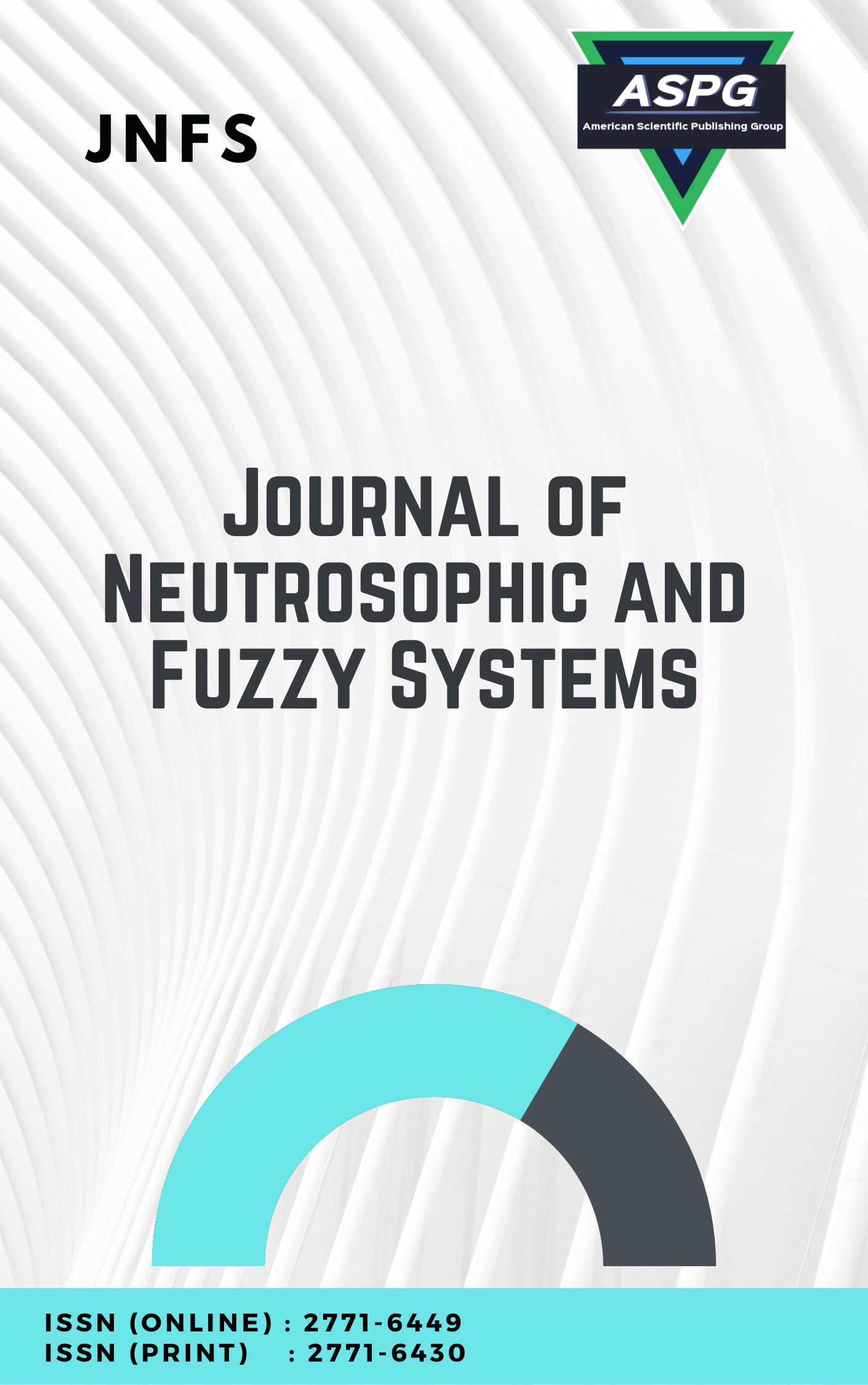

Volume 1 , Issue 2 , PP: 99-106, 2021 | Cite this article as | XML | Html | PDF | Full Length Article
Ahmed M. AbdelMouty 1 *
The importance of studying the relationships between colleges, businesses, and governments has grown as a result of the recent explosion of technical advancements. The potential for national economic growth is enhanced by the dissemination of new information discovered via research. When it comes to the generation of new information that can be used by established economies, universities play a crucial role. So, in this study we proposed a framework for select best strategy in higher education. This process contains many conflicting criteria, so the concept of multi-criteria decision making (MCDM) is used. The MCDM is integrated with the triangular neutrosophic sets to overcome the vague information. The COCOSO technique is proposed to rank the alternatives. Higher education officials, including government bureaucrats and academic administrators, may put the recommended approach to use.
Higher Education , Strategy Selection , MCDM , Neutrosophic Sets
[1] R. Wilson, G. Murray, and B. Clarke, “The RMIT belonging strategy: Fostering student engagement in higher education,” Research and development in higher education:(Re) valuing higher education, vol. 41, pp. 257–266, 2018.
[2] M. Spante, S. S. Hashemi, M. Lundin, and A. Algers, “Digital competence and digital literacy in higher education research: Systematic review of concept use,” Cogent Education, vol. 5, no. 1, p. 1519143, 2018.
[3] J. Crawford et al., “COVID-19: 20 countries’ higher education intra-period digital pedagogy responses,” Journal of Applied Learning & Teaching, vol. 3, no. 1, pp. 1–20, 2020.
[4] H. Aldowah, H. Al-Samarraie, and W. M. Fauzy, “Educational data mining and learning analytics for 21st century higher education: A review and synthesis,” Telematics and Informatics, vol. 37, pp. 13–49, 2019.
[5] N. W. Gleason, Higher education in the era of the fourth industrial revolution. Springer Nature, 2018.
[6] H. Zahavi and Y. Friedman, “The Bologna Process: an international higher education regime,” European Journal of Higher Education, vol. 9, no. 1, pp. 23–39, 2019.
[7] B. Alexander et al., “Horizon report 2019 higher education edition,” EDU19, 2019.
[8] O. Zawacki-Richter, V. I. Marín, M. Bond, and F. Gouverneur, “Systematic review of research on artificial intelligence applications in higher education–where are the educators?,” International Journal of Educational Technology in Higher Education, vol. 16, no. 1, pp. 1–27, 2019.
[9] L. Czerniewicz and K. Rother, “Institutional educational technology policy and strategy documents: An inequality gaze,” Research in Comparative and International Education, vol. 13, no. 1, pp. 27–45, 2018.
[10] A. Saha, I. Deli, and S. Broumi, “Hesitant triangular neutrosophic numbers and their applications to MADM,” Neutrosophic Sets and Systems, vol. 35, pp. 269–298, 2020.
[11] N. Singh, A. Chakraborty, S. B. Biswas, and M. Majumdar, “Impact of Social Media in Banking Sector under Triangular Neutrosophic Arena Using MCGDM Technique,” Neutrosophic sets and systems, vol. 35, pp. 153–176, 2020.
[12] M. Abdel-Basset, M. Mohamed, and F. Smarandache, “Linear fractional programming based on triangular neutrosophic numbers,” International Journal of Applied Management Science, vol. 11, no. 1, pp. 1–20, 2019.
[13] J. Fan, X. Jia, and M. Wu, “Green supplier selection based on dombi prioritized bonferroni mean operator with single-valued triangular neutrosophic sets,” International Journal of Computational Intelligence Systems, vol. 12, no. 2, pp. 1091–1101, 2019.
[14] S. Broumi, D. Nagarajan, A. Bakali, M. Talea, F. Smarandache, and M. Lathamaheswari, “The shortest path problem in interval valued trapezoidal and triangular neutrosophic environment,” Complex & Intelligent Systems, vol. 5, no. 4, pp. 391–402, 2019.
[15] A. Chakraborty, S. P. Mondal, A. Ahmadian, N. Senu, S. Alam, and S. Salahshour, “Different forms of triangular neutrosophic numbers, de-neutrosophication techniques, and their applications,” Symmetry, vol. 10, no. 8, p. 327, 2018.
[16] V. Choudhary and A. Mishra, “Analyzing the critical success enablers of industry 4.0 using hybrid fuzzy AHP–CoCoSo method,” Journal of Industrial Integration and Management, p. 2150018, 2021.
[17] X. Peng and F. Smarandache, “A decision-making framework for China’s rare earth industry security evaluation by neutrosophic soft CoCoSo method,” Journal of Intelligent & Fuzzy Systems, vol. 39, no. 5, pp. 7571–7585, 2020.
[18] A. E. Torkayesh, D. Pamucar, F. Ecer, and P. Chatterjee, “An integrated BWM-LBWA-CoCoSo framework for evaluation of healthcare sectors in Eastern Europe,” Socio-Economic Planning Sciences, vol. 78, p. 101052, 2021.
[19] M. Yazdani, Z. Wen, H. Liao, A. Banaitis, and Z. Turskis, “A grey combined compromise solution (CoCoSo-G) method for supplier selection in construction management,” Journal of Civil Engineering and Management, vol. 25, no. 8, pp. 858–874, 2019.
[20] A. E. Torkayesh, F. Ecer, D. Pamucar, and Ç. Karamaşa, “Comparative assessment of social sustainability performance: Integrated data-driven weighting system and CoCoSo model,” Sustainable Cities and Society, vol. 71, p. 102975, 2021.
[21] F. Ecer and D. Pamucar, “Sustainable supplier selection: A novel integrated fuzzy best worst method (F-BWM) and fuzzy CoCoSo with Bonferroni (CoCoSo’B) multi-criteria model,” Journal of Cleaner Production, vol. 266, p. 121981, 2020.
[22] M. Yazdani, P. Zarate, E. K. Zavadskas, and Z. Turskis, “A Combined Compromise Solution (CoCoSo) method for multi-criteria decision-making problems,” Management Decision, 2018.
[23] A. Ulutaş, C. B. Karakuş, and A. Topal, “Location selection for logistics center with fuzzy SWARA and CoCoSo methods,” Journal of Intelligent & Fuzzy Systems, vol. 38, no. 4, pp. 4693–4709, 2020.
[24] X. Peng and H. Huang, “Fuzzy decision making method based on CoCoSo with critic for financial risk evaluation,” Technological and Economic Development of Economy, vol. 26, no. 4, pp. 695–724, 2020.
[25] S. A. Edalatpanah, “A direct model for triangular neutrosophic linear programming,” International journal of neutrosophic science, vol. 1, no. 1, pp. 19–28, 2020.
[26] M. Mullai and R. Surya, “Neutrosophic inventory backorder problem using triangular neutrosophic numbers,” Neutrosophic Sets and Systems, vol. 31, pp. 148–155, 2020.
[27] S. K. Das and S. A. Edalatpanah, “A new ranking function of triangular neutrosophic number and its application in integer programming,” International Journal of Neutrosophic Science, vol. 4, no. 2, pp. 82–92, 2020.